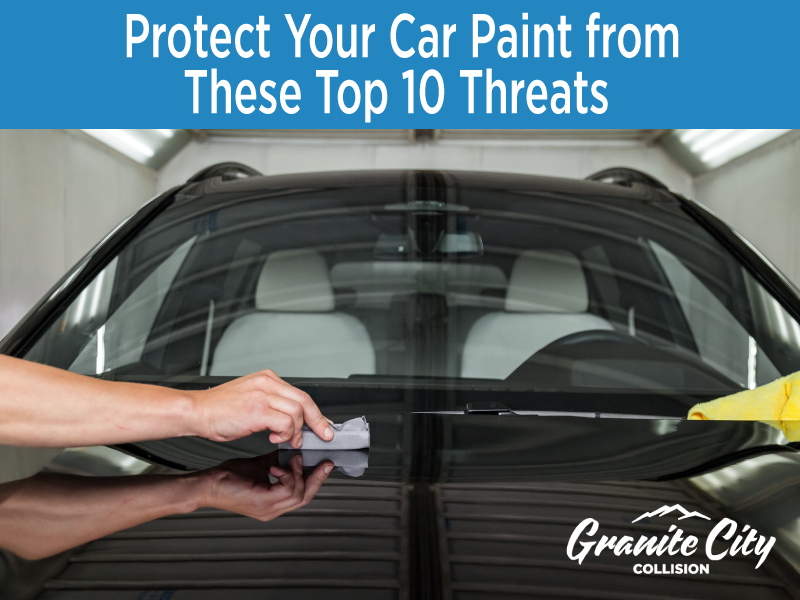The paint on your vehicle often indicates the condition of the rest of your vehicle. If your exterior paint looks as good as new, chances are you take good care of your car and keep up with regular maintenance. And aside from appearances, a shiny, clean paint job can boost your vehicle’s value if you ever choose to sell in the future.
With that in mind, there are obvious instances when you should take your vehicle in to get the paint repaired, such as when it’s damaged from a bump-up or a hit-and-run. But these aren’t the only instances that can mess up that pristine coat on your car. There are plenty of everyday items and substances that can deteriorate paint, and being able to identify them will help you avoid costly repairs. We’ve listed 10 of the most common threats to a vehicle’s exterior paint so that you’ll know what to do if yours is ever damaged:
1. Acidic and Sugary Beverages
Many people spill coffee, soda, juice, and other beverages on their car without realizing the damage it can do to the protective layer of paint. These types of drinks are high in acidity; if allowed to dry, they can eat away at and corrode the paint. Plus, any drinks with sugar will leave a residue, which excels the corrosion process and makes it harder to clean.
So, if you set your morning coffee or afternoon soda on top of your car, don’t drive off and forget about it! And if you do have a spill, be sure to wash your car as soon as you can.
2. Brake Fluid
If you do regular maintenance on your vehicle, you likely change your brake fluid from time to time. While this is a necessary part of upkeep, accidental spills of brake fluid can easily happen, in which case it’s essential to clean the spill immediately.
Silicone-based brake fluids are not as harmful to car paint as other types. But if you use a fluid that is caustic and not silicone-based, such as many older fluids, it can act as a kind of paint thinner. In that case, it will quickly eat away at the outer coat of your car’s paint, causing it to peel.
Along with being conscious of the brake fluid you use, be sure to clean up any spills as soon as they occur. Use a rag or towel to soak up the fluid; don’t wipe, as this can spread the fluid to other areas. Then, clean the spot with soap and water.
3. Gasoline
This happens even more often than brake fluid spills: You’re filling up at the gas station, and when you pull the nozzle out of your tank to put it back on the pump, gas leaks onto your car. You likely won’t see any damage because the gas will evaporate. But if left on for too long, it can cause deep stains that are hard to remove. If you get gas on your vehicle, take it through a car wash or clean it with mild soap and water as soon as you can.
It can also be worth getting your car waxed twice a year. This adds layers of protection to your car’s paint, which will prove useful in such instances.
4. Prank Items
Car pranks are part of American life, especially among younger people. And two of the most common items used for such pranks happen to be harmful to a car’s exterior paint—silly string and shaving cream. These substances contain resin and colorants that can do serious damage to the paint, particularly when left to dry in the sun.
Think about that the next time you’re tempted to use silly string or shaving cream on someone’s vehicle! If someone applies these substances to your vehicle, go through a car wash or clean your car with soap and water as soon as possible. If there is any residue left on your car after washing, you can use WD40 to remove it.
5. Bugs
Everyone gets bugs on their car. And while it’s common, it can also damage your vehicle’s exterior paint if left unaddressed. The body fluid of insects is often highly acidic. If bugs remain on your car, over time these fluids can dissolve your paint.
You won’t need to pull off the highway for an emergency car wash or anything, but regularly check your vehicle for bugs (especially around the grille and other areas in the front). When you notice bugs, spray a detergent and water on the area and allow the solution to sit for about 30 seconds. Then, gently wipe away the bug residue with a clean rag; don’t scrub, since this can cause scratches in the paint.
6. Bird Droppings
As with insects, bird droppings are a common culprit of vehicle paint damage. There’s no way to avoid getting droppings on your car, but it’s important to remove them as soon as you can. Yes, they can seriously tarnish the overall aesthetics of your vehicle. But droppings are also highly acidic, and if left to dry in the sun, they can harden and cause permanent damage to the paint.
Rather than let the bird droppings dry, clean them off the same way you would bugs. Wipe with a cleaning solution, and don’t scrub. You will need to let the solution sit for a few minutes if the droppings have hardened, as this will help dissolve the residue.
7. Salt
Salt is used in many areas of the country during winter to keep roadways clear of ice. While this makes for safer road conditions in cold temperatures, it can wreak havoc on the exterior paint of vehicles. In short, road salt can cause your car to rust and corrode if left untreated.
You can avoid this issue by washing your vehicle regularly during winter. You may also want to consider investing in a wax treatment or sealant for your car before the first snow hits your area.
8. Dust
Just like dust is bad in a home, it’s bad on your car. If you allow dust to accumulate on your vehicle and it mixes with rain, it can form an acidic compound that eats away at your exterior paint. Washing your car regularly will prevent this from happening and help to preserve its value.
9. Tree Sap
Tree sap can also cause significant damage to your car paint. If sap accumulates on your vehicle, it can eventually dissolve the clear coat and lead to discoloration and staining. This process is accelerated in hot environments.
Because of its stickiness, cleaning sap can be difficult. Nevertheless, you’ll want to remove it as soon as possible to prevent permanent damage. Wet a rag or cloth with rubbing alcohol or other preferred cleaning solution, and place the rag on the sappy area. Allow the solution to soak the area for at least 30 seconds, and then lightly wipe the area to remove the sap. You may need to repeat this process several times or use WD40 to get all the sap off.
10. Dirty Rags
You can be vigilant about cleaning your vehicle while unknowingly damaging it in the process. Keep this from happening by ensuring all the rags and towels you use are clean! Always clean with a fresh rag, and never place a rag on the ground between uses. Dirt and other particles easily become attached to rags, and using these rags can create lots of tiny scratches that become more and more noticeable over time.
How to Upkeep Your Paint
OK, so you’ve learned about some of the most common threats to your car’s paint job. Let’s add to the information above about how you can keep your paint clean and shiny:
Wash Regularly
Regularly taking your vehicle through a car wash is the most practical way to preserve the condition of its paint. This is also something you can do yourself. Just be sure to use a mild detergent when washing your vehicle, and use a clean microfiber drying towel to soak up any remaining water on your car’s surface. Avoid leaving your vehicle to air dry, as this can result in water minerals clinging to the paint, thus causing permanent damage.
Wipe Immediately
Anytime you notice an acidic substance on your car, clean it as soon as possible. Make sure you are using the appropriate cleaning solution, towel, and process for each instance. Do your research if you’re unsure what products to use for a particular substance. And remember that WD40 is your best friend for hardened or sticky substances like bird droppings and sap.
Wax Twice a Year
Get your car waxed at least twice a year—or every three months if your vehicle is frequently exposed to harsh natural elements. This is also something you can do yourself; just make sure you know what you’re doing, or you can cause damage to your car’s paint. And if you use WD40 on your paint, put a layer of wax on the area afterward to prevent the surface from stripping.
Use Clean Rags
As previously mentioned, it’s critical to use clean rags and towels when cleaning your car’s exterior. Remember to always use fresh rags and to never lay them on the ground between uses. Also, don’t assume that just because a towel is soft that it will be good for your car’s paint. The safest bet is to use microfiber washcloths and towels anytime you wipe your car’s paint.
Moreover, the environment plays a major role in how the paint on your car is impacted by substances. If you can, protect your vehicle from the sun, ice, and other elements by parking it in a covered area. This could mean a garage, a carport, or any other area that provides protection.
When to Bring Your Vehicle In
If your car’s paint has been damaged to the point of no return, or if you simply want to be proactive in fixing the damage before it gets worse, it might be time to bring your vehicle to an auto body shop. Local shops like Granite City Collision can get your car’s paint looking new again!
Many people try to brush touch their car’s paint job themselves. For tiny areas of damage, this can work, but only if you have experience. Still yet, you must factor in the time required and the costs of equipment and supplies. And if you’re unsatisfied with your DIY efforts, you may have to pay a professional to fix the damage anyway. All and all, taking your car to a professional auto body shop can be the most cost-effective solution for fixing a damaged paint job, regardless of the extent of the damage.
In Sum
There’s more than meets the eye when it comes to a car’s paint job. Keeping your paint in pristine condition can provide a significant boost in your car’s value and attract buyers should you ever decide to sell. Remember to watch out for the common threats above, and take any necessary precautions to protect your vehicle’s exterior paint. And don’t hesitate to come by Granite City Collision if you need a professional opinion or services!

